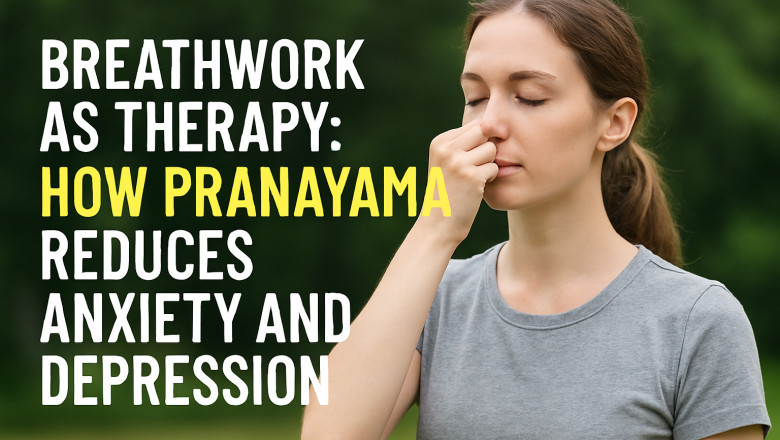views
In today’s hyper-connected world, anxiety and depression have quietly become two of the most common health issues affecting people across the globe. Whether it’s job-related stress, overwhelming life demands, emotional trauma, or simply the fast pace of modern life — mental health struggles are on the rise. But amidst pharmaceutical treatments and conventional therapies, an ancient practice from India is gaining ground as a powerful, holistic remedy: Pranayama.
Pranayama, the yogic science of breath control, has been practiced for thousands of years not only to improve physical health but also to calm the mind and nourish emotional well-being. Today, modern science is catching up to what ancient yogis always knew — breath is a powerful tool for healing. In this article, we explore how breathwork, particularly Pranayama, is proving to be a natural and effective way to manage anxiety and depression.
What is Pranayama? A Quick Introduction
The word Pranayama is derived from two Sanskrit words: “Prana” (life force) and “Ayama” (extension or control). It refers to the practice of consciously controlling the breath in various patterns to influence the flow of energy in the body and mind.
In yogic tradition, the breath is considered more than just oxygen intake — it's seen as the carrier of vital energy. By learning to regulate and deepen your breath, you’re not just improving physical health, but also achieving mental clarity and emotional stability.
Common Types of Pranayama:
Nadi Shodhana (Alternate Nostril Breathing)
Bhramari (Bee Breath)
Kapalabhati (Skull-Shining Breath)
Ujjayi (Oceanic Breath)
Anulom Vilom (Controlled Alternate Nostril Breathing)
Understanding Anxiety and Depression in the Modern Context
Before diving into how breathwork helps, let’s understand the conditions it targets.
❗ Anxiety is characterized by:
Excessive worry
Restlessness
Rapid heartbeat
Shallow breathing
Difficulty concentrating
❗ Depression often includes:
Persistent sadness
Fatigue
Loss of interest in activities
Sleep disturbances
Low self-worth
These conditions are not just emotional — they trigger physiological changes in the brain and body, such as overactivation of the sympathetic nervous system (fight or flight), hormonal imbalances, and inflammation.
Breath as the Bridge: How Pranayama Impacts the Mind-Body System
Breath is the only function in the human body that is both automatic and controllable. You can’t consciously control your heart rate or digestion — but you can control your breath. And through breath, you can influence your nervous system.
🌬️ Pranayama helps by:
Activating the parasympathetic nervous system (rest and digest mode)
Balancing oxygen and carbon dioxide levels in the blood
Reducing cortisol levels (stress hormone)
Enhancing vagal tone, which improves emotional regulation
Boosting serotonin and dopamine, neurotransmitters responsible for happiness and calm
When practiced consistently, Pranayama trains your nervous system to remain calm and resilient, even during stressful moments.
Scientific Evidence Supporting Pranayama for Mental Health
Over the past two decades, researchers have studied Pranayama’s effects on brain chemistry, hormone levels, and mental health outcomes. Here’s what the science says:
📚 Key Studies:
A study published in Journal of Clinical Psychology found that regular practice of Nadi Shodhana significantly reduced symptoms of generalized anxiety disorder in patients over 8 weeks.
Another research in the Indian Journal of Psychiatry observed that Bhramari Pranayama helped reduce symptoms of mild to moderate depression, especially in women.
A Harvard study noted that breathwork practices can rewire neural pathways and improve emotional regulation in patients with PTSD, anxiety, and mood disorders.
These results are consistent with the lived experiences of thousands of practitioners around the world.
Top 5 Pranayama Techniques for Anxiety and Depression
1. Nadi Shodhana (Alternate Nostril Breathing)
This calming technique involves inhaling through one nostril and exhaling through the other in an alternating pattern.
✅ Benefits:
Balances brain hemispheres
Lowers blood pressure
Reduces racing thoughts
2. Bhramari (Bee Breath)
A gentle humming sound is made during exhalation, creating soothing vibrations in the skull.
✅ Benefits:
Eases tension in the forehead
Helps with insomnia and headaches
Induces a meditative state
3. Ujjayi (Ocean Breath)
This technique involves slightly constricting the throat during breathing, producing a soft ocean-like sound.
✅ Benefits:
Improves focus and mindfulness
Promotes relaxation
Supports energy balance in the body
4. Anulom Vilom (Basic Alternate Nostril Breathing)
A beginner-friendly version of Nadi Shodhana, focusing purely on alternate nostril breathing without breath retention.
✅ Benefits:
Reduces irritability and mood swings
Clears mental fog
Enhances emotional resilience
5. Kapalabhati (Skull-Shining Breath)
This involves forceful exhalations and passive inhalations, acting as a detox for the body and mind.
✅ Benefits:
Energizes and uplifts mood
Stimulates brain function
Clears sluggish mental states
Emotional Healing through Breath
Mental health isn’t just about what happens in the brain — it’s also deeply rooted in emotions stored in the body. Breathwork allows you to access and release trapped emotional energy.
Here’s how it works:
-
When you’re anxious, your breath becomes short and rapid.
-
When you’re depressed, your breath is slow and shallow.
-
Conscious breath retrains your body to shift these emotional patterns.
This is why many people report crying, releasing deep grief, or feeling light and happy after a session of intense breathwork.
Integrating Pranayama Into Daily Life
You don’t have to sit for hours to benefit from Pranayama. Even 10–15 minutes of conscious breathing each day can have profound effects on your emotional health.
🔁 Sample Daily Routine:
-
Morning: 5 mins Anulom Vilom + 5 mins Kapalabhati (energizing)
-
Midday: 2 mins deep belly breathing (re-centering)
-
Evening: 10 mins Bhramari + Nadi Shodhana (relaxing)
Pair your breathwork with gentle asana practice, mindful walking, or meditation for even deeper results.
Breathwork vs. Medication: Can Pranayama Replace Pills?
This is a common question. The answer? It depends.
For mild cases of anxiety and depression, Pranayama may be sufficient on its own. For moderate to severe cases, it can serve as a powerful complementary therapy alongside medication and counseling.
Pranayama empowers individuals to take an active role in their healing






















Comments
0 comment